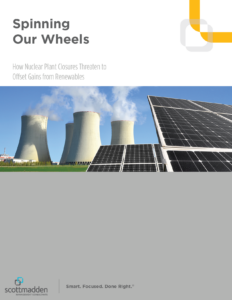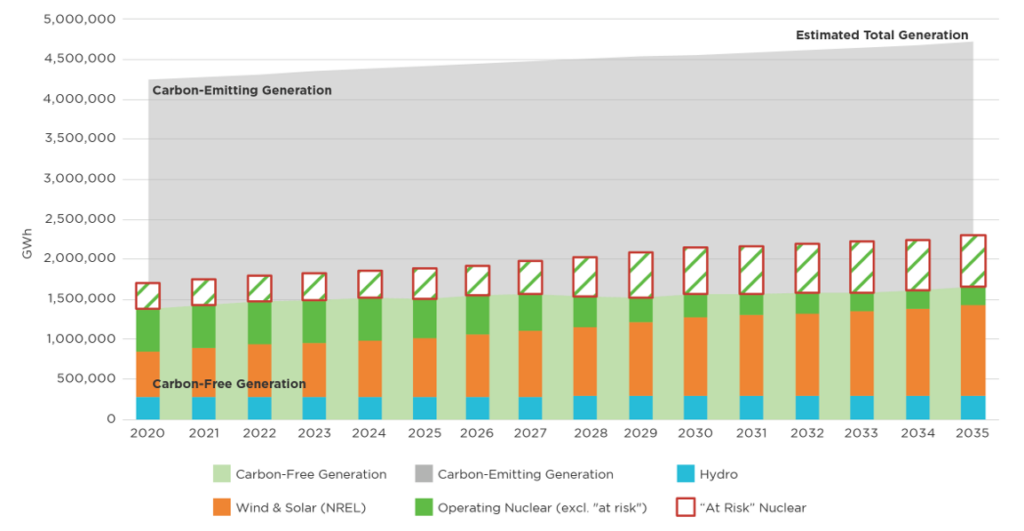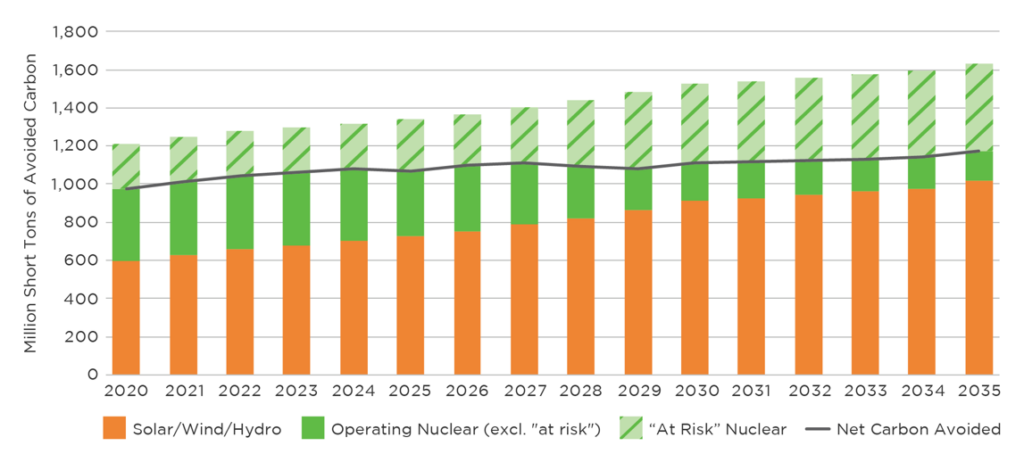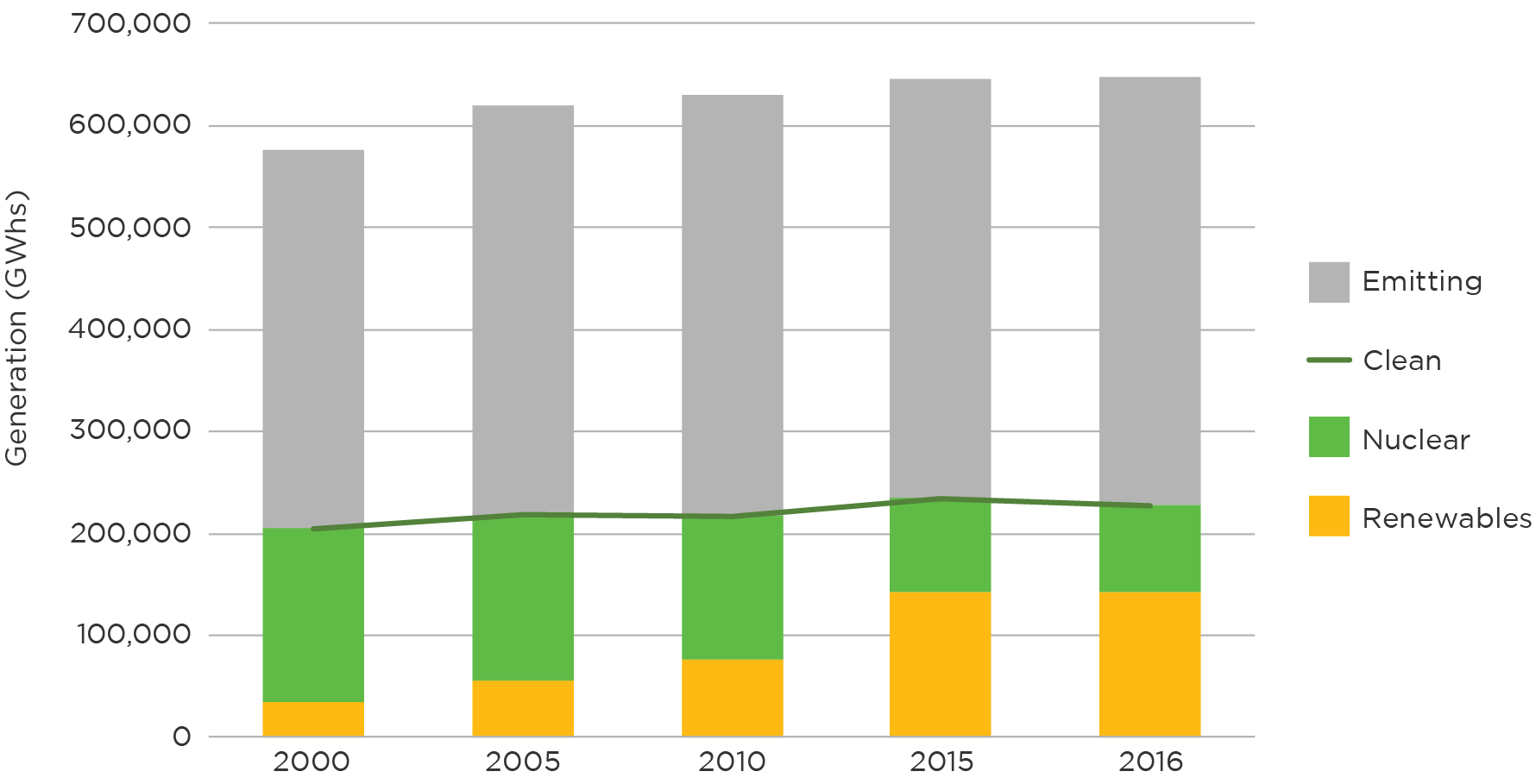
 The United States has worked to combat climate change by focusing on lowering the greenhouse gas (GHG) emissions from the electric generation sector. One key strategy has been to invest in the growth of renewables, principally solar and wind. This strategy, underpinned by tax incentives, has helped wind and solar grow from 1.3% in 2008 to 8.8% in 2018 of the electricity produced in the United States. Adding that to existing hydro and nuclear (both GHG emission free), the United States now gets 35.2% of its generation from clean sources (chart 1). That is the good news.
The United States has worked to combat climate change by focusing on lowering the greenhouse gas (GHG) emissions from the electric generation sector. One key strategy has been to invest in the growth of renewables, principally solar and wind. This strategy, underpinned by tax incentives, has helped wind and solar grow from 1.3% in 2008 to 8.8% in 2018 of the electricity produced in the United States. Adding that to existing hydro and nuclear (both GHG emission free), the United States now gets 35.2% of its generation from clean sources (chart 1). That is the good news.
Now the bad news. If the United States was to meet the Paris Agreement goals of 80% decarbonization of the entire economy by 2050, many agree that the electric generation sector would need to achieve 100% decarbonization, a nearly tripling of the amount of carbon-free generation currently provided by wind, solar, hydro, and nuclear. To make such meaningful progress is not a choice between nuclear and renewables, but a need to keep and grow both, as both technologies can displace carbon-emitting generating sources. Despite the significant renewable capacity growth in the past decade, meaningful gains in carbon-free generation are in jeopardy due to the risk of early nuclear plant retirements.
The United States is currently facing early retirement (before a unit’s current operating license expires) of existing, well-running nuclear power plants. This puts a significant source of carbon-free electricity generation at risk of being lost. This threat has emerged due to a combination of low power prices (due to low cost natural gas generation) and the lack of market compensation for nuclear’s carbon-free electricity.

Why does this matter? Are we not replacing nuclear with wind and solar? Unfortunately, as long as fossil fuels are being used to generate electricity, every nuclear plant lost represents a missed opportunity to displace fossil fuels. A typical two-unit nuclear plant displaces 8.4–13.6 million short tons of carbon annually. The reality is that shuttered nuclear plants are replaced mostly by output from existing fossil plants. This represents a “give back” of progress that could have made by adding wind and solar. Further, meaningful impacts on climate will require not just deep but quick reductions in carbon. Loss of nuclear will only further delay decarbonization at a time it is needed most.
In a previous white paper, ScottMadden investigated how large this “give back” of progress might be. We calculated the potential for loss of carbon-free generation due to early nuclear retirements. The basis year 2008 was selected to align with the beginning of the focus on investment in new solar and wind. The term “at risk” was defined to categorize nuclear plants at risk of early retirement:
For each “at risk” category, we calculated the annual electricity production of each plant.
Thus, if all the “at risk” plants are allowed to close without any actions to save them, 47% of all carbon-free electricity sources are lost. Even more striking, nearly 90% of the wind and solar output that has been added since 2008 would be given back to fossil sources. Without intervention, the United States will have very little progress to show for its efforts and investments in renewables over the past decade.

While this initial analysis may be bleak, perhaps the future may present a better picture. Can we grow our way out of this problem with more renewables? To answer this, ScottMadden developed a new analysis projecting electricity production from carbon-free sources over the next 15 years, based on projected growth in renewables and potential future nuclear plant retirements. Fifteen years was chosen as a pivotal period if deep, near-term decarbonization is to be achieved.
For generation from renewables, we estimated growth in wind (onshore and offshore), solar (utility-scale and distributed), and hydro based upon forecasts from the U.S. Department of Energy’s National Renewable Energy Laboratory (NREL). While there are many other sources for forecasts, NREL’s forecast is generally more optimistic than others.
For nuclear generation, we reassessed our same four “at risk” categories, adding new early retirements based on current license expiration dates and the following assumptions:
For total electricity generation, we used projections from the U.S. Energy Information Administration.
Based on this new projection, the United States can expect little to no improvement in its clean energy position. Even using the relatively rosy NREL projections of renewables growth, total carbon-free generation barely grows 20% by 2035, a far cry from the roughly tripling needed to achieve full decarbonization.
Figure 3: Estimated U.S. Carbon Emissions-Free Power Generation (2020–2035) (in GWhs)

Early retirement of all “at risk” nuclear plants would represent a give back of more than 649,000 GWh in 2035. This loss of nuclear generation represents more than 460 million short tons of CO2.[1] For perspective, this is equivalent to emissions of approximately 100 million cars or more than one-third of the vehicles on the road today. Even with the projected growth in renewables, the “avoided carbon” from all clean energy sources barely improves as the contribution from nuclear falls from a total of roughly 615 million short tons to only 155 million short tons if these plants are allowed to retire.
Figure 4: Contribution to Carbon Avoidance

If this comes to pass, the United States will have made little to no progress in displacing fossil fuels. Clean sources will remain less than 40% of the electric sector. Further, if electrification of other sectors, including transportation, occurs more quickly than anticipated in the projections, the total electricity generation requirement will be much greater, opening the door for more fossil-fueled generation.
To achieve deep and quick decarbonization, the United States will need all existing non-CO2-emitting generation plus a lot more.
ScottMadden’s projection of the U.S. clean energy future is just that, a projection. Aren’t there other nations further along on the decarbonization path that can provide a better window into the future?
Many have pointed to Germany as a bellwether in deployment of renewables. In 2000, nearly two decades ago, the Renewable Energy Act established feed-in tariffs and priority grid access for renewables. The action represented a key milestone in the Energiewende—or transition to a low-carbon economy. Since then, the country has spent more than $222 billion on renewable subsidies. Renewable energy as a percentage of gross electricity generation has increased from 6.2% in 2000 to 37.8% in 2018. At the same time, however, Germany has embarked on a strategy of closing its nuclear plants. Roughly 40% of Germany’s nuclear plants were shut down in 2011. The resulting historical performance of Germany’s clean electricity production has eerily mirrored our projection for the United States.
Figure 5: 2018 German Electricity Net Generation Mix (GWhs)

How has Germany fared? Despite the addition of significant renewable resources, there is limited progress in reducing total carbon emissions in the electricity sector. From 2000 to 2016, GHG emissions have decreased roughly 4%. Why? Coal has maintained its role as the single largest source of electricity generated.
And the cost? In 2017, Germany had the highest power prices in Europe, with households paying more than 30 Eurocents per kWh compared to an average of less than 20 Eurocents per kWh for the rest of Europe.

What next? Germany still has seven operating nuclear power plants, all expected to close by 2022. It bears watching what the impacts will be on future GHG emissions and prices when the last of the nuclear fleet retires.
Figure 7: U.S. Operating* and Potentially “At Risk” Commercial Nuclear Plants

Solar and wind have provided great contributions to emission-free electricity generation, an important step toward reducing carbon emissions. However, the progress created by solar and wind carbon-free generation is in danger of being given back due to early retirement of currently operating nuclear plants. Contrary to some assertions, lost nuclear is not fully replaced by renewables. Instead, the void left is filled by carbon-emitting, fossil fuel generation. Thus, retaining “at risk” nuclear would avoid more than 460 million short tons of carbon on top of the contribution made by renewables. Bottom line: if the goal is to grow overall clean energy in a significant way, the United States will need to preserve existing zero-carbon resources and develop more zero-carbon resources, such as renewables and nuclear.
[1] Our analysis uses the average regional CO2 intensity from The Brattle Group’s 2016 whitepaper, “Nuclear Retirement Effects on CO2 Emissions: Preserving a Critical Clean Resource.” In reality, CO2 emissions from electricity in the United States vary by region and could range from 315 short million tons to 509 short million tons.
Additional Contributing Author: Benjamin Lozier
View MoreSussex Economic Advisors is now part of ScottMadden. We invite you to learn more about our expanded firm. Please use the Contact Us form to request additional information.